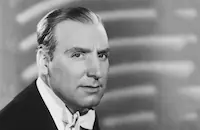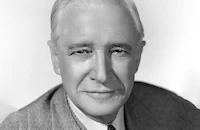Berkeley Square

Brief Synopsis
Cast & Crew
Frank Lloyd
Leslie Howard
Heather Angel
Valerie Taylor
Irene Browne
Beryl Mercer
Film Details
Technical Specs

Synopsis
In 1784, wealthy American Peter Standish arrives in England to court a distant cousin, Kate Pettigrew, whose impoverished family is of the best bloodline. At the Pettigrew home, Kate's brother Tom and mother, Lady Ann, urge her to charm Peter into proposing to her so that they will be able to pay off their debts. Meanwhile, her sister Helen is visited by her unwanted but wealthy suitor, Mr. Throstle. Just as Peter is about to enter the house, the scene dissolves to 1933 London, to the modern day Pettigrew home, where the current Peter Standish, an American architect who is a descendant of the former Peter, is surveying his inheritance. His fiancée, Marjorie Trant, arrives and grows worried at Peter's distracted appearance. He has spent the past three days studying the former Peter's detailed diaries and brooding about the lives of his ancestors. Marjorie persuades Peter to join her for tea with the American ambassador, to whom Peter explains that on this day, 149 years ago, the original Peter arrived at the Pettigrew home. Peter also relates his belief that if he returns to the house at precisely the same time that his ancestor arrived, he will be transported to 1784. The ambassador tells Peter that if he did go back, he would have to be careful not to alter history, after which Peter rushes home. His "theory" comes true, and it is he, rather than the original Peter, who is greeted by Kate. The Pettigrews are dismayed by their strange cousin, who seems to know about things that have not yet happened and who speaks most peculiarly. Only Helen is more intrigued than frightened by Peter's oddities, and as the days pass, the couple fall in love, even though Peter has already proposed to Kate as he was supposed to do according to the original Peter's diaries. Peter is at first charmed by the simplicity of life in the 1700's, but gradually becomes disgusted by his acquaintances' small-mindedness and lack of hygiene. After several incidents in which Peter's strange ways embarrass them, the Pettigrews, except for Helen, become convinced that a demon is inhabiting Peter's body. Helen, desperate to learn her beloved's secret, looks deep into his eyes and is horrified to see aspects of the future: World War I, gangsters, trains and modern cities. Peter and Helen confess their love for each other, and Peter determines to stay, even though he has changed history. However, the animosity between the other Pettigrews and Peter finally reaches a boiling point, and Peter is convinced by Helen that he must return to his own time. She tells him that she will always be with him and gives him an Egyptian statue of the symbol of eternal life. Peter reluctantly returns to 1933, much to the relief of his maid, Mrs. Barwick, Marjorie and the ambassador, who claim that Peter had been drinking heavily and rambling about being from the eighteenth century. Peter then visits Helen's grave and is shocked to learn that he did change history, for instead of living out her life with Throstle, Helen died in 1787. Peter tells Marjorie that he cannot marry her, and as he grieves for Helen, he is comforted by her voice assuring him that they will be together "in God's time."

Director
Frank Lloyd
Cast

Leslie Howard

Heather Angel
Valerie Taylor

Irene Browne
Beryl Mercer
Colin Keith-johnston

Alan Mowbray

Juliette Compton
Betty Lawford
Ferdinand Gottschalk

Samuel Hinds
Olaf Hytten
David Torrence
Hylda Tyson
Crew
Joseph Aiken
Joe Badaracco
John L. Balderston
Lance Baxter
Al Block
William Darling
Louis De Francesco
Jack Epstein
George Hadden
William Lambert
Jesse L. Lasky
Sonya Levien
Bud Manners
Charles E. Mccarthy
Ernest Palmer
Dave Regan
Harold Schuster
William Tummel

Videos
Movie Clip



Film Details
Technical Specs

Award Nominations
Best Actor
Articles
Berkeley Square
The story and thematic thrust will immediately remind you of Woody Allen's recent hit Midnight in Paris (2011) - which also in its way entertained the grass-is-greener fondness for old Europe and past ages and then put those delectations under a hot magnifying glass. Here, we meet Peter Standish (Leslie Howard) first as a post-Revolution American visiting cousins in 1784 London - but as he goes to enter the house on Berkeley Square, the camera dollies across the room, loses focus, and then backs out again, and suddenly we're in 1933, when a new generation's Standish is obsessed to an unhealthy degree with the London house he's inherited and its history. This brooding fool is already losing his fiancée (Betty Lawford) and seeing the American Ambassador (Samuel S. Hinds) as a kind of therapy, but soon enough he transcends time, off-screen, and by sheer dint of will enters into the 18th century, to live the life of his ancestor.
There, he confronts his cousin's family and social whorl, impulsively proposes to the wrong sister (Valerie Taylor), and raises suspicions by way of his manners and speech. Eventually he comes around to the younger sister (Heather Angel), with whom he falls in love, but it's clear by then that Standish's dreams of the refined, beautiful life of 1784 are dissolving in their confrontation with reality. (His apparent foresight of things to come even gets him accused of witchcraft by the older sister, and he cannot help but admit that the 18th century just stinks.) Based on a hit play by John Balderston (who had a fabulous run as a screenwriter in the 30s, including Dracula [1931],Frankenstein [1931], The Mummy [1932], The Lives of a Bengal Lancer [1935], and Mad Love [1935]), Berkeley Square is gloriously stagy, utilizing a standard early-talkie two-shot in most scenes, a trope that today is so simple and clear it's refreshing. Lloyd, who'd win an Oscar® that same year for Cavalcade, and another in 1935 as the director/producer of Mutiny on the Bounty, was no self-conscious artiste, and in 1933 neither he nor his audience saw anything wrong with simply making the film of a hit play rather play-like - all the better to let the characters speak their minds and to let the tale roll forward.
There are moments when this classical strategy is disrupted - most memorably when Angel's dewy maiden learns the truth about her beloved and witnesses, by looking into his eyes, a furious montage of history leading from the 1800s through to WWI and beyond - a scalding vision for a cloistered British teen of 1784. Because his credits have never been finalized, this sequence may or may not have been engineered by one of Hollywood's most peculiar specialists: Slavko Vorkapich, a Serbian montagist who worked for years for various studios crafting transitional or expository found-footage montage scenes, with pacing and ingenuity no one could match. His name even became a noun in studio parlance, instead of "montage." Berkeley Square's frenetic summation of early 20th-century madness has Vorkapich's fingerprints all over it, but thanks to early studios' carefree way with employees' credits, for now its provenance must remain a mystery.
Of course stage-based projects like Berkeley Square depend on the personal energies of their casts. Howard, it should be said, is one of the 1930s' greatest enigmas, an effete but beloved movie star who has a very tough time translating to contemporary times. No arthouse theater in this country has ever held a Leslie Howard retrospective. Self-conscious and so British he practically curdles like old milk in tea, Howard appealed to the wispy Anglophile in Americans' hearts, particularly women, and although he always seemed too foppish to be truly modern (his inciting presence as Scarlett O'Hara's obsession in Gone with the Wind [1939] is the only cast decision in that film about which we might scratch our heads), Howard had in fact a fascinating man's-man history, from his shell-shocking on the fields of WWI (and the subsequent decision to try acting as therapy), to his efforts to help England's cause during WWII, when in 1943 he eventually had his passenger plane shot down by the Luftwaffe. Knowing this context puts Howard's moody, peculiar escapist Peter Standish in a strange new light - especially when you consider how the ghost-memory of WWI haunts the film, just as it did Howard.
Berkeley Square is very much an artifact of its day, then, when nothing, it still seemed, could overshadow the traumas of The Great War. But in the end it exudes a jaundiced cynicism about nostalgia in general - which, it could be said, was a defining principle for the system of empires and treaties and gentleman armies that allowed the war to ignite in the first place. Just by visiting the 18th century Standish renders it for himself banal and frustrating, and arrives in his modern day just as Owen Wilson's hero from Allen's movie did 80 years later: with a Buddhist-like appreciation for the here and now, and no desire to look backward.
Producer: Jesse L. Lasky
Director: Frank Lloyd
Screenplay: John L. Balderston (screenplay and play); Sonya Levien (writer); Henry James (unfinished novel "The Sense of the Past")
Cinematography: Ernest Palmer
Music: Peter Brunelli, Louis De Francesco, J.S. Zamecnik (all uncredited)
Film Editing: Harold D. Schuster
Cast: Leslie Howard (Peter Standish), Heather Angel (Helen Pettigrew), Valerie Taylor (Kate Pettigrew), Irene Browne (Lady Ann Pettigrew), Beryl Mercer (Mrs. Barwick), Colin Keith-Johnston (Tom Pettigrew), Alan Mowbray (Major Clinton), Juliette Compton (Duchess of Devonshire), Betty Lawford (Marjorie Frant), Ferdinand Gottschalk (Mr. Throstle).
BW-84m.
by Michael Atkinson

Berkeley Square
Quotes
Trivia
Notes
Leslie Howard co-produced, directed and starred in the 1929 London production of John L. Balderston's play (6 March 1929), as well as the Broadway production (4 November 1929). Valerie Taylor and Irene Browne also reprised their roles from the Broadway production for this film. After the picture's opening credits, there is a written statement reading: "How many of us have wished that we might escape from the dull reality of the present into the glamor and romance of yesterday? But if we could journey back into the mystery of the past, should we find contentment-or unhappiness?" According to the Twentieth Century-Fox Records of the Legal Department at the UCLA Theater Arts Library, Arthur Bryon was originally cast as the American ambassador. Although Margaret Clancy is listed as editor in a final shooting script dated April 5, 1933 in the Twentieth Century-Fox Producted Scripts Collection, also at UCLA, Harold Schuster is credited as editor in material dated after the film was produced. It is not known if Clancy actually worked on the film. Howard was nominated for an Academy Award for Best Actor, and the film was named one of the ten best pictures of 1934 in the Film Daily poll of critics. Howard and Helen Chandler performed the play on a Lux Radio Theater broadcast in December 1934. On March 3, 1949, David Niven starred in a radio broadcast on the story on The Hallmark Playhouse. In 1951, Ray Baker directed Tyrone Power and Ann Blyth in I'll Never Forget You, which was Twentieth Century-Fox's remake of this film. Among the television dramatizations of Berkeley Square are: a March 20, 1949 version directed by Paul Nickell and starring William Prince and Leueen MacGrath; a February 13, 1951 show directed by Donald Davis and starring Richard Greene and Grace Kelly; and a February 5, 1959 presentation directed by George Schaefer and starring John Kerr and Edna Best.














